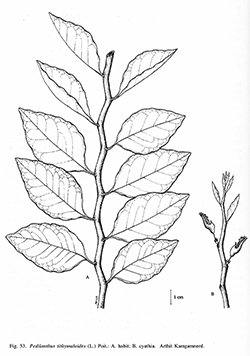e-Flora of Thailand
Volume 8 > Part 2 > Year 2007 > Page 471 > Euphorbiaceae > Pedilanthus
Pedilanthus tithymaloides (L.) Poit.wfo-0000266214
Ann. Mus. Natl. Hist. Nat. 19: 390, pl. 19. 1812; Kurz, Forest Fl. Burma 2: 418. 1877; Dressler, Contrib. Gray Herb. 182: 137. 1957; Fl. Bhutan 1: 763, pl. 47 c, d. 1987; Wijnands, Bot. Commelijns: 104. 1983; J.S.Ma, Fl. Reipubl. Pop. Sin. 44(3): 128. 1997. Fig. 53.
Accepted Name : Euphorbia tithymaloides L.
Sp. Pl.: 453. 1753.
Description : Shrub, up to ca 2 m high, with succulent stem, deciduous and usually flowering when leafless. Indumentum present on young parts, later glabrous. Stipules ca 0.5 mm long, caducous. Leaves slightly succulent; petiole 2–5 mm long; blade ovate to elliptic, base attenuate, margin entire, apex acute to obtuse, slightly brighter below venation hardly visible, midvein strongly keeled below, side veins ca 9 pairs, not triplinerved. Cyathia partly red (in particular spur), partly green, spur short (less than 3 mm long), bracts less than 15 mm long, glands 4. Fruits 5–6 mm in diam., sulcate. Seeds subglobose, 3–4.5 by 2.5–3 mm, greyish-brown (not known from Thailand).
Thailand : Common in cultivation, but rarely collected.
Distribution : The most widespread species of the genus, from the USA (Florida) to northern S America and most of the Antilles. Eight subspecies distinguished, most of them local endemics on the Antilles.
Ecology : In the Americas, growing in a wide range of habitats, in coastal scrub, arid thorn forests, dry deciduous forests, or in exposed, rocky sites of more humid environments, and more frequent on limestone.
Vernacular : Sayaek (แสยก)(Central).
Uses: Garden ornamental, often utilised as low hedge.
Notes: The distinction between the subspecies seems to be less clearcut in Thailand than in their American origin. Dressler, in the latest revision of Pedilanthus, attributed the cultivated plants of tropical Asia to subsp. smallii, but based on leaf sizes most of the Thai plants studied must be attributed to subsp. tithymaloides despite their notable zig-zag stems.
1. Stems markedly and conspicuously zig-zag; young leaves and stems glabrous to sparsely pubescent; leaves 2.5–7 by 1.3–3.2 cm; cyathial bracts 5–7 mm long subsp. smallii
1. Stems straight to moderately zig-zag; young leaves and stems glabrous to densely pubescent; leaves 1–16 by 0.8–10 cm; cyathial bracts 4–14 cm long subsp. tithymaloides

